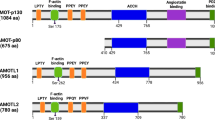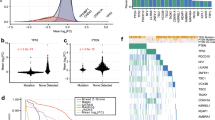Abstract
The WTX, Wilms tumor-associated tumor-suppressor gene, is present on the X chromosome and a single WTX mutation may be sufficient to promote carcinogenesis. Unlike the WT1 tumor suppressor, a transcription factor, WTX lacks conserved functional protein domains. To study the function of WTX, we constructed inducible cell lines expressing WTX and tumor-associated WTX mutants. Induction of WTX inhibited cell growth and caused G1/G0 arrest. In contrast, a short, tumor-associated truncation mutant of WTX358 only slightly inhibited cell growth without a significant cell-cycle arrest, although expression of a longer truncation mutant WTX565 led to the growth inhibition and cell-cycle arrest to a similar extent as wild-type WTX. Like WT1, WTX slowed growth and caused cell-cycle arrest through p21 induction. Gene expression profiling showed that these two tumor-suppressors regulated genes in similar pathways, including those implicated in control of the cellular growth, cell cycle, cell death, cancer and cardiovascular system development. When gene expression changes mediated by wild-type WTX were compared with those affected by mutant forms, WTX565 showed a 55% overlap (228 genes) in differentially regulated genes, whereas WTX358 regulated only two genes affected by wild-type WTX, implying that amino-acid residues 358–561 are critical for WTX function.
This is a preview of subscription content, access via your institution
Access options
Subscribe to this journal
Receive 50 print issues and online access
$259.00 per year
only $5.18 per issue
Buy this article
- Purchase on Springer Link
- Instant access to full article PDF
Prices may be subject to local taxes which are calculated during checkout






Similar content being viewed by others
References
Bardeesy N, Beckwith JB, Pelletier J . (1995). Clonal expansion and attenuated apoptosis in Wilm's tumors are associated with p53 gene mutations. Cancer Res 55: 215–219.
Bennett CN, Longo KA, Wright WS, Suva LJ, Lane TF, Hankenson KD et al. (2005). Regulation of osteoblastogenesis and bone mass by Wnt10b. Proc Natl Acad Sci USA 102: 3324–3329.
Chung NG, Kim MS, Chung YJ, Yoo NJ, Lee SH . (2008). Tumor suppressor WTX gene mutation is rare in acute leukemias. Leuk Lymphoma 49: 1616–1617.
Englert C, Maheswaran S, Garvin AJ, Kreidberg J, Haber DA . (1997). Induction of p21 by the Wilm's tumor suppressor gene WT1. Cancer Res 57: 1429–1434.
Grohmann A, Tanneberger K, Alzner A, Schneikert J, Behrens J . (2007). AMER1 regulates the distribution of the tumor suppressor APC between microtubules and the plasma membrane. J Cell Sci 120: 3738–3747.
Huff V . (1998). Characterization of a wilms tumor in a 9-year-old girl with trisomy 18. Am J Med Genet 79: 260–267.
Jenkins ZA, van Kogelenberg M, Morgan T, Jeffs A, Fukuzawa R, Pearl E et al. (2009). Germline mutations in WTX cause a sclerosing skeletal dysplasia but do not predispose to tumorigenesis. Nat Genet 41: 95–100.
Kim MK, Mason JM, Li CM, Berkofsky-Fessler W, Jiang L, Choubey D et al. (2008). A pathologic link between Wilms tumor suppressor gene, WT1, and IFI16. Neoplasia 10: 69–78.
Kim MK, McGarry TJ, Obroin .P, Flatow JM, Golden AA, Licht JD . (2009). An integrated genome screen identifies the Wnt signaling pathway as a major target of WT1. Proc Natl Acad Sci USA 106: 11154–11159.
Koesters R, Ridder R, Kopp-Schneider A, Betts D, Adams V, Niggli F et al. (1999). Mutational activation of the beta-catenin proto-oncogene is a common event in the development of Wilm's tumors. Cancer Res 59: 3880–3882.
Kreidberg JA, Sariola H, Loring JM, Maeda M, Pelletier J, Housman D et al. (1993). WT-1 is required for early kidney development. Cell 74: 679–691.
Li CM, Kim CE, Margolin AA, Guo M, Zhu J, Mason JM et al. (2004). CTNNB1 mutations and overexpression of Wnt/beta-catenin target genes in WT1-mutant Wilm's tumors. Am J Pathol 165: 1943–1953.
Maiti S, Alam R, Amos CI, Huff V . (2000). Frequent association of beta-catenin and WT1 mutations in Wilms tumors. Cancer Res 60: 6288–6292.
Major MB, Camp ND, Berndt JD, Yi X, Goldenberg SJ, Hubbert C et al. (2007). Wilms tumor suppressor WTX negatively regulates WNT/beta-catenin signaling. Science 316: 1043–1046.
Morrison DJ, Kim MK, Berkofsky-Fessler W, Licht JD . (2008). WT1 induction of mitogen-activated protein kinase phosphatase 3 represents a novel mechanism of growth suppression. Mol Cancer Res 6: 1225–1231.
Morvan F, Boulukos K, Clement-Lacroix P, Roman Roman S, Suc-Royer I, Vayssiere B et al. (2006). Deletion of a single allele of the Dkk1 gene leads to an increase in bone formation and bone mass. J Bone Miner Res 21: 934–945.
Ogawa O, Eccles MR, Szeto J, McNoe LA, Yun K, Maw MA et al. (1993). Relaxation of insulin-like growth factor II gene imprinting implicated in Wilm's tumour. Nature 362: 749–751.
Ohlsson R, Nystrom A, Pfeifer-Ohlsson S, Tohonen V, Hedborg F, Schofield P et al. (1993). IGF2 is parentally imprinted during human embryogenesis and in the Beckwith-Wiedemann syndrome. Nat Genet 4: 94–97.
Owen C, Virappane P, Alikian M, Stasevich I, Summers K, Lillington D et al. (2008). WTX is rarely mutated in acute myeloid leukemia. Haematologica 93: 947–948.
Park JS, Valerius MT, McMahon AP . (2007). Wnt/beta-catenin signaling regulates nephron induction during mouse kidney development. Development 134: 2533–2539.
Perotti D, Gamba B, Sardella M, Spreafico F, Terenziani M, Collini P et al. (2008). Functional inactivation of the WTX gene is not a frequent event in Wilm's tumors. Oncogene 27: 4625–4632.
Rivera MN, Haber DA . (2005). Wilm's tumour: connecting tumorigenesis and organ development in the kidney. Nat Rev Cancer 5: 699–712.
Rivera MN, Kim WJ, Wells J, Driscoll DR, Brannigan BW, Han M et al. (2007). An X chromosome gene, WTX, is commonly inactivated in Wilms tumor. Science 315: 642–645.
Rivera MN, Kim WJ, Wells J, Stone A, Burger A, Coffman EJ et al. (2009). The tumor suppressor WTX shuttles to the nucleus and modulates WT1 activity. Proc Natl Acad Sci USA 106: 8338–8343.
Ruteshouser EC, Robinson SM, Huff V . (2008). Wilms tumor genetics: mutations in WT1, WTX, and CTNNB1 account for only about one-third of tumors. Genes Chromosomes Cancer 47: 461–470.
Schmidt-Ott KM, Masckauchan TN, Chen X, Hirsh BJ, Sarkar A, Yang J et al. (2007). beta-catenin/TCF/Lef controls a differentiation-associated transcriptional program in renal epithelial progenitors. Development 134: 3177–3190.
Strathdee CA, McLeod MR, Hall JR . (1999). Efficient control of tetracycline-responsive gene expression from an autoregulated bi-directional expression vector. Gene 229: 21–29.
Wegert J, Wittmann S, Leuschner I, Geissinger E, Graf N, Gessler M . (2009). WTX inactivation is a frequent, but late event in Wilms tumors without apparent clinical impact. Genes Chromosomes Cancer 48: 1102–1111.
Weksberg R, Shen DR, Fei YL, Song QL, Squire J . (1993). Disruption of insulin-like growth factor 2 imprinting in Beckwith-Wiedemann syndrome. Nat Genet 5: 143–150.
Yoo NJ, Kim S, Lee SH . (2009). Mutational analysis of WTX gene in Wnt/ beta-catenin pathway in gastric, colorectal, and hepatocellular carcinomas. Dig Dis Sci 54: 1011–1014.
Acknowledgements
This work is supported by a grant from the Northwestern Memorial Foundation.
Author information
Authors and Affiliations
Corresponding author
Ethics declarations
Competing interests
The authors declare no conflict of interest.
Additional information
Supplementary Information accompanies the paper on the Oncogene website
Supplementary information
Rights and permissions
About this article
Cite this article
Kim, MH., Min, D., Rabin, M. et al. Functional characterization of Wilms tumor-suppressor WTX and tumor-associated mutants. Oncogene 30, 832–842 (2011). https://doi.org/10.1038/onc.2010.452
Received:
Revised:
Accepted:
Published:
Issue Date:
DOI: https://doi.org/10.1038/onc.2010.452
Keywords
This article is cited by
-
Identification of a small mutation panel of coding sequences to predict the efficacy of immunotherapy for lung adenocarcinoma
Journal of Translational Medicine (2020)
-
The General Expression Analysis of WTX Gene in Normal and Cancer Tissues
Pathology & Oncology Research (2017)



